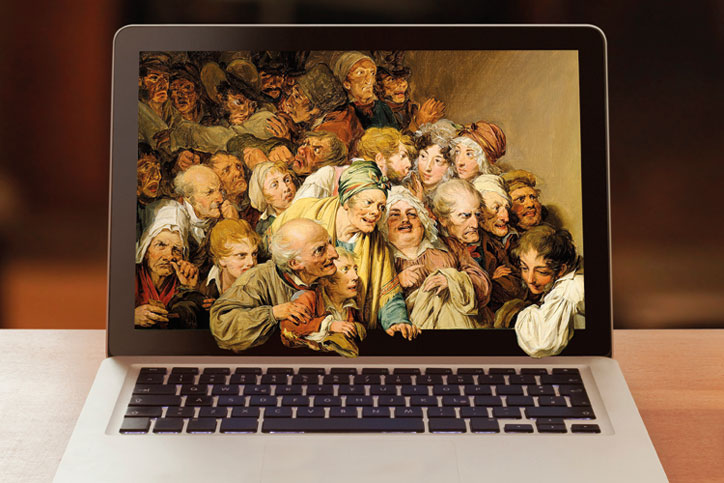I learned that there is no shame in not having the answers to all questions...scientists should never be regarded as oracles
As with most important aspects of life, my serious involvement with public engagement began with a random occurrence that gave rise to a transformative experience. I had previously undertaken the occasional favour and, armed with Anolis lizards and Siberian hamsters, gone into schools to talk about animals in general terms, coping with perceptive questions such as “how do snakes mate?”, “why is wee-wee yellow?” and “why do my brother’s feet smell?”. I also recollect an invitation to give a talk in the mid-1980s about my PhD research, and being informed by a senior academic that “the key thing you have to establish as quickly as possible, when talking to the public, is the collective [level of] stupidity of the audience, and adjust your lecture accordingly” – which, to the modern ear, seems almost as insensitive as serving bacon baguettes at a bar mitzvah.
These early forays had not prepared me for the chain of events triggered by a call from the university switchboard in the mid-1990s that went along the lines of: “Glad I caught you, Russell. These people contacted us who want to bring scientists and musicians together to do stuff in schools – I wasn’t sure who to speak to – would you take the call?” My positive response (how could I say no in the circumstances?) initiated a collaboration with the Orchestra of the Age of Enlightenment that has lasted for 20 years.
The philosophy was simple: expose children to the excitement of science, use the science to inform musical expression and use original music generated by the children to reinforce the understanding of the science. This formula has proved itself repeatedly, and convinced me that the concept of the “two cultures” – science and the humanities, forever in conflict – is nonsense. An early project is still vivid in my memory. I arrived at the Henry Wood Hall in South London to talk to more than 200 eight- to 10-year-olds about the nature of cells and DNA, and how to extract the latter from kiwi fruit when they were back in their classrooms. I approached my task with military precision. It was to be a brute force use of imagery to convey the glory of biology, and I knew exactly what I would say as each of my carefully generated slides was projected on to the wall. Anticipating the audible gasps they would elicit, I had even prepared a suitably indulgent smile.
I was eager to start, but failed to identify any sort of projector. When I asked politely where it was, the organiser’s chuckling response was: “Oh, my dear chap, we don’t have anything like that here…you’ll just have to improvise.” Aware that there were young ears close by, I hissed my protests into his ear: “Bloody hell! How do you expect me to sodding well improvise a sodding cell and DNA?” Another even louder chuckle. I was clearly on my own and terror consumed me. This was not my world, there was no plan B and spontaneity was not part of the package. I was the scientist facing 200 children, their teachers and the musicians, and I had no bloody idea what to do.
Adrenaline-driven physiology can initiate everything from murder to an acute bowel movement. In this instance, something more constructive emerged. A sea of smiling little faces looked up at me expectantly, and I asked haltingly for them to think of a number between one and 10. I next requested all those who had chosen a number less than six to get up, hold hands and form a ring in the middle of the hall. This represented the cell’s plasma membrane. A smaller ring formed the nuclear membrane; children rushing between the two formed the liquid cytoplasmic contents, and the chromosomes stood tall in the middle with arms outstretched. It worked! Another part of the same project involved using detergent to break down the cell membranes to release DNA. The teachers became the detergent molecules, zooming in and tickling the outer children under their arms to disrupt the “membranes” and release the chromosomes. It worked again! In fact, more than that, it was a triumph!
I had experienced a new way of communicating, far more tangible than a set of images projected on to a wall. By becoming the cell, the children gained a physical understanding of its basic components. For me, the experience was both sobering and enlightening. I realised for the first time that while it is usually good to be ruthlessly prepared, it is also perfectly fine, and sometimes even better, to have the confidence to be spontaneous.
The musicians seemed to enjoy the interactions too. On another occasion, a final performance took place in the Queen Elizabeth Hall on London’s South Bank. For this project – again, designed for children – different parts of the orchestra were to depict the various organ systems of the body, illustrating the importance of our organs – like the musicians – working together. Deciding who in the orchestra would be what body part, and how to include the brass section in a decorous manner, was the source of both creativity and immense laughter. Sir Mark Elder, who conducted the performance, kicked things off with undiluted relish, saying “I am the brain: I tell them what to do”, followed by the double bass as the heart and eventually the horns – as the muscles.
My second transformative experience was with another remarkable organisation: the Cheltenham Science Festival. I am ashamed to admit that it took me a while to embrace how things were done under the inspired leadership of Kathy Sykes and Mark Lythgoe. Despite my experiences with the musicians and children, I – like many scientists – still stuck to a tired, traditional approach to conveying science to adults. The format was simple. Speaking for 50 minutes or more in an hour-long slot, you delivered a diluted research talk followed by a few short questions, before returning to the laboratory with a sense that your duty had been done. When I was first asked to speak at Cheltenham, I was, like all speakers, instructed, gently but very firmly, not to speak for longer than 20 minutes. This was shocking. Asking an academic not to dwell on every nuanced detail of their research is a bit like asking a dog not to pee against a gatepost. The next body blow was the realisation that the question and answer session would dominate. Like a cold hand on the vitals, I appreciated that this would mean loss of control. Once again I had to be able to think on my feet, and what if I could not answer the questions? But this time it would be much worse, as smiling and forgiving children would be replaced by critical and articulate adults.
I relearned that preparation combined with spontaneity can be a winning formula. I also learned that there is no shame in not having the answers to all questions. It makes the point that scientists should never be regarded as oracles. I also grasped that real engagement is about so much more than providing the correct answer. The delivery of accurate facts is vital, of course, but often it is just as necessary that they are conveyed with kindness and tact, especially when individuals reveal remarkable and deeply personal details about themselves in public. Questions I have been asked, in front of hundreds of listeners, range from the frankly tactless (“So, in your view, when is the best time to have sex?”) to the deeply moving (“I have breast cancer: when should I have my chemotherapy?”).
I have also learned that engagement is bilateral. In my direct experience, amazing questions are sometimes asked that make you think about your science afresh. One colleague based an entire grant application on a chain of thought triggered by a question from a member of the audience. Cheltenham, like other science festivals, also encourages speakers to stay on after the session to allow discussions to continue long after the scheduled event has ended. What dawned on me, with the speed of a slug on amphetamines, was that a short, focused presentation in combination with a longer period of genuine and interactive discussion delivers so much more than a “lecture”. Today, such a model is taken for granted by my early career colleagues. This is wonderful.
But public engagement is a bit like a ripe, odorous Camembert. You can’t fail to be aware of it, but it is not to everyone’s taste. Institutions of higher learning are broadly appreciative of the effort, and less sceptical about its worth than they were 20 years ago. They even appoint directors of public engagement – and not merely as a pragmatic response to funders’ emphasis on research with “impact”, and the availability of more grants for public engagement projects. However, very few universities or funding bodies reward their researchers for engaging. You could argue that it is part of the job and that rewards are therefore inappropriate. However, I do feel that the efforts of early career scientists in particular should be recognised. For example, the many university research fellows who undertake large amounts of public engagement could be given a six-month extension of their fellowships.
However, doing that might be complicated by the increasing confusion I have noticed about the meaning of public engagement. I was astonished the other day when an earnest individual opened a meeting with the statement: “You will be relieved to hear that we are not going to try and define what is meant by public engagement.” I was tempted to say that if we don’t know why we are here, then I’m off for a coffee. But I held my tongue and sat mesmerised as a succession of highly coloured graphs and pie charts whizzed by, purporting to represent impact and participation. Of course I know that pie charts are important, but I don’t feel that they can capture easily how far attitudes towards public engagement have changed. Today, many of my early career colleagues seek out opportunities to engage and are completely committed to the philosophy that science should be accessible and scientists should not to be hidden away in silos. This was not the case 20 years ago. I also wonder how audience laughter, learning, wonder and inspiration can be captured in an Excel spreadsheet.
So what is public engagement for me? Everything I have learned from working with the Cheltenham Science Festival and the Orchestra of the Age of Enlightenment, as well as the Royal Society Public Engagement Committee and the Wellcome Trust, has convinced me that its philosophy should involve three essential aims. First, it should strive to transfer information from a specialist to non-specialists, allowing all sectors of society to enjoy the wonder of scientific knowledge and to use it to make more evidence-based decisions. Second, scientists should actively solicit the comments, concerns and interests of non-scientists in order to act to correct confusion and misrepresentation. And third, scientists and non-scientists should draw on each other’s strengths and expertise for the dissemination of knowledge, the refinement of government strategy and, where appropriate, the implementation of change.
But, for scientists and engineers, there remains one big question – the pachyderm in the room, if you like. Why bother? Why not stay in our labs, doing what we are good at, and leave all science communication to the increasing number of brilliant professional science communicators?
The answer is that we need both scientists and science communicators to work together on public engagement. After all, if you want to know what it is like to drive a car, you really need to hear from the driver as well as the observant passenger. Scientists provide an immediacy and authenticity about our subject; and while our answers may not always be the most articulate or entertaining, they will always be the most informed.
Russell Foster is professor of circadian neuroscience and director of the Sleep and Circadian Neuroscience Institute at the University of Oxford. His latest public engagement project, teaching schoolchildren about the importance of changing rhythms in sleep and music, will be launched in 2016 in collaboration with the Orchestra of the Age of Enlightenment, with funding from the Wellcome Trust.

Public engagement is near invariably a cordial, convivial process. Online, however, it is a different story
As universities clamour for examples of impact that they can submit to the next research excellence framework, academics are under increasing pressure to develop public-facing activities as part of their research. Public engagement is also a welcome opportunity to demonstrate to a seemingly hostile government the value of the humanities and their contribution to the intellectual life of the nation.
Moreover, when successful, public engagement is both fun and immensely rewarding for academics and the public alike. The audience encounters something entirely new, or perhaps hears opinions that might change their perspective on an issue. Meanwhile, academics get to showcase material perhaps unsuited to an academic monograph, and to field the kinds of questions that are not necessarily forthcoming from a roomful of scholars.
So, for us as early career researchers in the humanities, public engagement is part of the academic landscape and has been instrumental in helping to develop past projects. As well as public lectures, our past projects have included workshops and art exhibitions. We have also done our best to publicise our research via the media. But although this can be a great opportunity to bring your research to a national or even global audience, we have both recently discovered that it can also be especially nerve-racking and fraught with challenges.
For one thing, it can mean relinquishing control over how your work is presented. Even when you write the article yourself, some publications routinely and arbitrarily change titles and copy for greater impact, or to pursue a quirkier angle regardless of how it fits with your argument. These are usually benign editorial decisions: a helping hand to the academic used to restrained prose. But the changes can dramatically alter how the public perceives your work.
In person, public engagement is near invariably a cordial, convivial process. Participants may remain unconvinced or even downright opposed to your argument, but this is part of the appeal, and it offers an opportunity to engage in productive discussion. Few will be openly disparaging about your work to your face. Online, however, it is a different story.
We have both appeared in the national press recently in relation, respectively, to the publication of a monograph about spy fiction, British Spy Fiction and the End of Empire, and the launch of a Wellcome Trust-funded project on the history of beards and health. Through this, we’ve become aware of how much reactions to academic work depend on how it is presented. Some of the 50 or so comments elicited by the article one of us wrote for The Guardian on British Spy Fiction were very supportive. Others disagreed with its take on the genre, and many were miffed at the omission of their favourite book. Some missed the point altogether, seeing the piece as propping up an outdated vision of an England-dominated UK.
Still, even this was small beer compared with reactions to the Daily Mail’s take on the launch of the beards project, headlined “A stubble first for university academic who will spend three years studying the history of beards”. The article itself was brief but factual. It made very clear that this is a serious study and presented the rationale for doing it. Within hours, however, the comments board lit up. “And these eggheads get paid for this?” one asked. “Why doesn’t he do a study titled, ‘Why I am so stupid’?” Another asked: “Why? Oh yes it keeps him employed for 3 years and then he can think of the next waste of money to employ him for another 3 years[…] Do something useful.” And a third declared: “The man obviously hasn’t any skills or ability to do something worthwhile with his life. He would be just as much use to society by sitting at home on welfare.”
While such comments are not pleasant to read, it’s a free country. People have a right to their opinions and the internet offers an immediate, highly public forum to express them. As was stressed in a BBC media training session we attended, putting your head above the parapet inevitably means dodging the snipers, and having a quirky topic, such as the history of facial hair, certainly provides ammunition! But, on a deeper level, these comments highlight the apparent gulf between how academics and the public assess the value of research – not to mention the inability of some people to read articles carefully before launching into public tirades.
As in the examples quoted above, funding figured large in the 85 comments on the Daily Mail story. Many decried the project as a “waste of public money”. An academic colleague added a comment pointing out that – as the story itself clearly stated – the project was actually funded by the Wellcome Trust, but this only served to provoke a further set of furious reactions to the notion that a charity was “wasting” money on research into facial hair, instead of curing cancer. Other comments were based on the assumption that the story was about a new degree course. “Ever wondered why a degree was so expensive?” asked one. “Courses like this should be struck off the university curricculum [sic]”. Another read: “Well I am sure big business will be queuing up for the signature of someone passing such a useful degree.”
And it’s not just us. Kingston University’s Will Brooker was another recent recipient of commenters’ ire. His current project on David Bowie involves an attempt to – as he put it in the press release – inhabit the iconic singer’s “head space at points in his life and career to understand his work from an original angle” by dressing, acting and living as Bowie for a year. While we can debate the merits of Brooker’s embodied approach to cultural research, commenters on social media and newspaper websites were more interested in disparaging Brooker’s project, his profession, his institution and, it seems, his very existence. Even Times Higher Education’s story elicited similar reactions.
The open nature of such discussions throws up another question for the public-facing academic: should you wade in and engage with the comments? The temptation is obvious, especially if you feel the comment has misinterpreted your piece or, worse, used it as an excuse to grind an axe. In our recent press encounters, we both resisted the temptation, opting instead for dignified silence. Still, when the phrase “comments are now closed for this article” appeared on The Guardian article, seldom had such a banal collection of words brought with it such a feeling of relief.
It’s difficult to gauge the popularity of projects that generate controversy with the university executive, which is the branch of an institution most concerned with building and managing a brand. But it could be argued that building a media profile, or at least maintaining a good relationship with various forms of media, is increasingly necessary for academics in the modern era. Engaging with different groups encourages us to be innovative in our approaches to lectures and seminars, and to think about our “audience” and its particular needs, making us more effective lecturers and tutors in the process. And experience suggests that students actually like it if their lecturer has a media profile.
There are more and more television programmes and channels, magazines, blogs, Twitter feeds and Facebook groups all catering to a voracious public appetite for popular history, and all inviting academic input. It would be a terrible shame if we did not respond. We should embrace the fact that modern scholars have more opportunities to engage with the public than any previous generation did. But, personally, we might think twice before reading the comment threads next time.
Sam Goodman is a lecturer in English and communication at Bournemouth University. Alun Withey is an associate research fellow in history at the University of Exeter.

Engagement aficionados: female researchers in humanities among the most involved
Recent research “highlights a sense of ambiguity and confusion among researchers surrounding public engagement and its place in their professional lives”, according to a major report published on 2 December.
The report, Factors Affecting Public Engagement by Researchers, says that many funders of UK public research have recently begun to invest serious sums in public engagement, while more than half of researchers polled consider public engagement to be as important as other aspects of their jobs. The report, financed by a consortium of funders of UK research led by the Wellcome Trust, also finds that experienced researchers have perceived increases in the amount and quality of public engagement carried out over the past decade. Eight out of 10 researchers have had some involvement in public engagement in the past year (although for more than half that was confined to social media) and a significant proportion – and young researchers in particular – would like to do more.
There is some evidence that public engagement is more common among more senior and female researchers in the social sciences and, especially, the arts and humanities. Researchers in the latter fields are also more likely to deem public engagement to be as important as other professional tasks, to believe it can improve their research and to undertake “interactive and dialogic” forms of engagement (as opposed to the mere communication of information) that funders prefer.
But the report also acknowledges research suggesting that “public engagement often struggles to compete for time and resources within the context of a profession that is overwhelmingly driven by reward and recognition for research itself”. “Many” institutions have no formal structures for rewarding public engagement, and training in delivering it – which research suggests boosts participation – is also rare, although more than half of the researchers polled feel “fairly well” equipped to do it. Researchers say that they often struggle to find opportunities to participate in public engagement, or that they do not see a public relevance to their research, while professional “facilitators” of public engagement often find it very difficult to encourage researchers to get involved. The report concludes that higher education is “a sector in transition with respect to public engagement”.
POSTSCRIPT:
Print headline: Up close and personal
Register to continue
Why register?
- Registration is free and only takes a moment
- Once registered, you can read 3 articles a month
- Sign up for our newsletter
Subscribe
Or subscribe for unlimited access to:
- Unlimited access to news, views, insights & reviews
- Digital editions
- Digital access to THE’s university and college rankings analysis
Already registered or a current subscriber?





